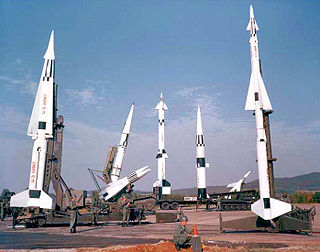
Project Nike was a U.S. Army project, proposed in May 1945 by Bell Laboratories, to develop a line-of-sight anti-aircraft missile system. The project delivered the United States' first operational anti-aircraft missile system, the Nike Ajax, in 1953. A great number of the technologies and rocket systems used for developing the Nike Ajax were re-used for a number of functions, many of which were given the "Nike" name . The missile's first-stage solid rocket booster became the basis for many types of rocket including the Nike Hercules missile and NASA's Nike Smoke rocket, used for upper-atmosphere research.

The Strategic Rocket Forces of the Russian Federation or the Strategic Missile Forces of the Russian Federation is a separate-troops branch of the Russian Armed Forces that controls Russia's land-based intercontinental ballistic missiles (ICBMs). It was formerly part of the Soviet Armed Forces from 1959 to 1991.

The Black Sea Fleet is the fleet of the Russian Navy in the Black Sea, the Sea of Azov and the Mediterranean Sea. The Black Sea Fleet, along with other Russian ground and air forces on the Crimean Peninsula, are subordinate to the Southern Military District of the Russian Armed Forces. The fleet traces its history to its founding by Prince Potemkin on 13 May 1783 as part of the Imperial Russian Navy. The Russian SFSR inherited the fleet in 1918; with the founding of the Soviet Union in 1922, it became part of the Soviet Navy. Following the collapse of the Soviet Union in 1991, the Black Sea Fleet was partitioned between the Russian Federation and Ukraine in 1997, with Russia receiving title to 82% of the vessels.

The P-800 Oniks, marketed in export as the Yakhont, is a Soviet / Russian supersonic anti-ship cruise missile developed by NPO Mashinostroyeniya as a ramjet version of P-80 Zubr. Its GRAU designation is 3M55, the air launched Kh-61 variant was planned but never built. The missile has the NATO codename SS-N-26 "Strobile". Development commenced in 1983, and in the 1990s the anti-ship missile was tested on the Project 1234.7 ship. In 2002 the missile passed the whole range of trials and was commissioned. It is reportedly a replacement for the P-270 Moskit, and possibly also of the P-700 Granit.
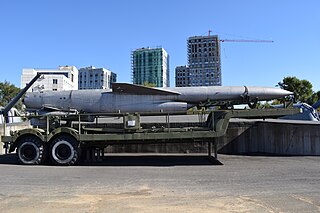
The P-500 Bazalt is a turbojet-powered, supersonic cruise missile used by the Soviet and Russian navies. Its GRAU designation is 4K80 and its NATO reporting name is SS-N-12 Sandbox, its upgraded version being the P-1000 Vulkan AShM SLCM.

The P-5 "Pyatyorka", also known by the NATO codename SS-N-3C Shaddock, is a Cold War era turbojet-powered cruise missile of the Soviet Union, designed by the Chelomey design bureau. The missile entered service in 1959. Pyatyorka is a common name for the missile as the "digit 5", corresponding to the R-7 Semyorka, the digit 7.

The Zvezda Kh-35 is a Soviet turbojet subsonic cruise anti-ship missile. The missile can be launched from helicopters, surface ships and coastal defence batteries with the help of a rocket booster, in which case it is known as Uran or Bal. It is designed to attack vessels up to 5,000 tonnes.

The 9K720 Iskander is a mobile short-range ballistic missile system produced and deployed by the Russian military. They travel at a terminal hypersonic speed of 2100–2600 m/s and can reach an altitude of 50 km as they range up to 500 km. The missile systems (Искандер-М) were intended to replace by 2020 the supposedly-obsolete OTR-21 Tochka systems in the Russian military.

Metel Anti-Ship Complex is a Russian family of anti-submarine missiles. There are different anti-submarine variants ('Metel') for cruisers and frigates, and a later version with a shaped charge ('Rastrub') that can be used against shipping as well as submarines.
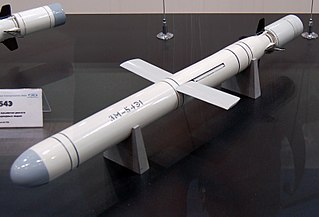
The Novator Kalibr, also referred to as 3M54-1 Kalibr, 3M14 Biryuza, is a family of Russian cruise missiles developed by NPO Novator (OKB-8). It first saw service in 1994. There are ship-launched, submarine-launched and air-launched versions of the missile, and variants for anti-ship, anti-submarine and land attack use. Some versions have a second propulsion stage that initiates a supersonic sprint in the terminal approach to the target, reducing the time that air defense systems have to react, while subsonic versions have greater range than the supersonic variants. The missile can carry a warhead weighing up to 500 kilograms (1,100 lb) of explosive or a thermonuclear warhead.

The RS-24 Yars also known as Topol-MR, NATO reporting name SS-29 or SS-27 Mod 2), is a Russian MIRV-equipped, thermonuclear armed intercontinental ballistic missile first tested on May 29, 2007, after a secret military R&D project.

Varyag was the fourth and final ship of the Soviet Navy Project 58 Groznyy-class Guided Missile Cruisers, also known as the Kynda Class.
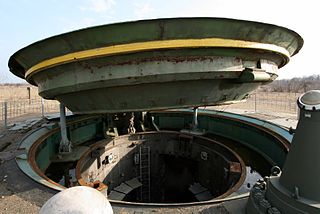
A missile launch facility, also known as an underground missile silo, launch facility (LF), or nuclear silo, is a vertical cylindrical structure constructed underground, for the storage and launching of intercontinental ballistic missiles (ICBMs), intermediate-range ballistic missiles (IRBMs), medium-range ballistic missiles (MRBMs). Similar facilities can be used for anti-ballistic missiles (ABMs).

The K-300PBastion-P is a Russian mobile coastal defence missile system. The system was developed together with the Belarusian company Tekhnosoyuzproekt.

The Pacific Fleet is the Russian Navy fleet in the Pacific Ocean.

The Western Electric System 1393 Radar Course Directing Central (RCDC) was a Cold War complex of radar/computer systems within the overall Improved Nike Hercules Air Defense Guided Missile System. The RCDC was installed at the "battery control areas" of ~5 hectares each which was for commanding a nearby missile Launching Area (LA), firing a missile from the LA, and guiding a launched missile to a burst point near an enemy aircraft.
The RS-28 Sarmat, often colloquially referred to as Satan II by media outlets, is a Russian liquid-fueled, HGV-equipped and FOBS-capable super-heavy intercontinental ballistic missile (ICBM) produced by the Makeyev Rocket Design Bureau. It is intended to replace the Soviet R-36M ICBM in Russia's arsenal.
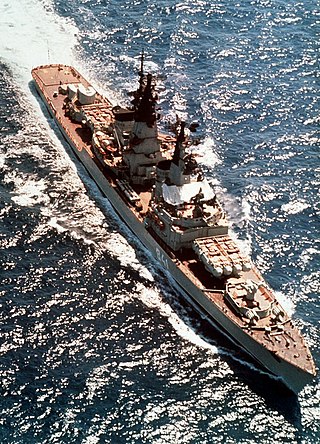
Admiral Golovko was the third ship of the Soviet Navy Project 58 Groznyy-class Guided Missile Cruisers, also known as the Kynda Class.
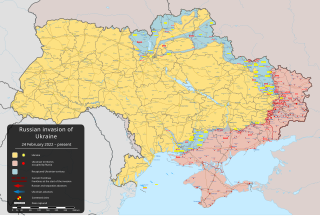
Beginning in July 2022, a series of explosions and fires occurred on the Russian-occupied Crimean Peninsula from where the Russian Army had launched its offensive on Southern Ukraine during the Russian invasion of Ukraine. Occupied since 2014, Crimea was a base for the subsequent Russian occupation of Kherson Oblast and Russian occupation of Zaporizhzhia Oblast. The Ukrainian government has not accepted responsibility for all of the attacks.


















